Carbohydrate portion sizes in pregnancy
This page gives you information about carbohydrates and the recommended portion sizes for women with diabetes during their pregnancy.
On this page
What are carbohydrates?
Carbohydrates are a macronutrient; one of the basic food groups. When carbohydrates are eaten, they are broken down into glucose molecules, also referred to as sugar molecules, in our body. Carbohydrates can cause blood glucose levels to rise. We need insulin to take these glucose molecules into our body’s cells, where we can use them for energy.
How much carbohydrate should I eat?
You should aim to have 3 main meals each day with around a fist-size portion (or 30g to 45g) of starchy carbohydrate.
You may find that you need to reduce your breakfast carbohydrate portion to 15g to 20g to keep your blood glucose levels within the target range. If this is the case, it is best to avoid breakfast cereals as most are high glycaemic index carbohydrates.
Be mindful of portion sizes and carbohydrate content of different brands. To find out the amount of carbohydrate in a product look at the ‘Total Carbohydrate’ on the packaging. You may need to work out the amount per portion.
Try to choose wholemeal (high fibre) starchy carbohydrate options where possible.
Which foods contain carbohydrates?
The term carbohydrate includes 2 different types of carbohydrates. One is simple or “sugary” carbohydrates and the other is complex or “starchy” carbohydrates.
You also need to consider the fat content and processing status of the food to help you make the best choice for you.
Sugary carbohydrates
| Types | Examples |
| Foods containing natural sugars | Fruit (fresh, dried, frozen or tinned), milk, yoghurt, custard |
| Sugary foods/foods with added sugars | Table sugar, syrup, honey, treacle, jam, marmalade, cakes, biscuits, pastries, chocolates, ice-cream, sweets |
| Sugary drinks with added sugars | Fruit juice, smoothies, cola, lemonade, energy drinks, Lucozade® original. |
Starchy carbohydrates
| Types | Examples |
| Potato and starchy vegetables | Sweet potato, plantain, yam |
| Pasta | Fresh, dried, tinned, noodles |
| Bread | White, wholemeal, granary, chapatti, naan, pitta, ciabatta |
| Rice | White, brown, basmati, risotto |
| Breakfast cereals | Cornflakes, rice crispies, muesli, porridge, bran flakes |
| Grains | Cous-cous, barley, semolina, cornmeal |
| Savoury pastry | Pies, sausage rolls, Cornish pasties. These are classed as processed foods |
| Flour products | Pancakes, Yorkshire puddings |
| Savoury snacks | Crisps, nachos, tortilla chips, pretzels, rice cakes, poppadom’s, crackers, crisp breads, bread sticks |
| Breaded and battered foods | Fish fingers, scotch eggs, battered fish |
Carbohydrate content of some foods
Breakfast cereals
Note: Milk also contains carbohydrate. Consider the amount you add to cereal.
Bread, pasta, rice and potatoes
Bread, pasta, rice and potatoes continued
Bread, pasta, rice and potatoes continued
Example meals
Example meals continued
Lower carbohydrate food ideas
- Eggs (boiled/scrambled/poached/omelette) on 1 to 2 slices of seeded/wholegrain toast*.
- Avocado on 1 to 2 slices of seeded/wholegrain toast*.
- Cold meats/cheeses with snack size croissant (only occasionally as high in fat).
- Low fat Greek yogurt with handful blueberries/raspberries/strawberries.
- Porridge oats (jumbo)/All bran with semi skimmed milk.
- Low fat cream cheese on half a bagel or a crumpet.
*You could also try sourdough bread, rye bread, and pumpernickel bread (mix of sourdough and rye).
Main meals
- Aim for no more than a fist-sized portion of starchy carbohydrates; such as bread, chappati, potato, pasta, rice or noodles.
- Try slower releasing (low GI) carbohydrates such as basmati rice, wholemeal pasta, sweet potato, new potatoes, buckwheat, quinoa etc.
- Aim for half of your plate to be filled with salad / vegetables; such as lettuce, cucumber, tomatoes, broccoli, green beans, carrots, peas etc.
- Try courgette or squash noodles to help increase your vegetable intake and reduce your carbohydrate portions.
- Add beans and lentils to meals such as bolognaise, stews, casseroles.
What about snacks?
Choose low carbohydrate snacks in-between meals. Aim for no more than 10g to 15g of carbohydrate. They should have little or no effect on your blood glucose levels.
Snacks
- “High protein” yoghurt for example, 15+g protein per serving (100 to200g).
- 1 portion of fruit at a time, spread out across the day (1 portion = 1 apple/small banana/40g berries).
- Small handful (20g) of unsalted nuts (cashews, almonds, walnuts etc) or seeds.
- 1 to 2 oatcakes / crispbreads / Ryvita / plain ricecake.
- Peanut butter or low fat cheese spread on 1 to 2 oatcakes / crispbread / rice cake or on 1 slice of seeded / wholegrain toast.
- Olives and feta cheese with cherry tomatoes.
- Hummus / sour cream / cottage cheese / nut butter with carrot, cucumber and celery sticks.
- Cold meats.
- Hardboiled eggs.
- Plain popcorn.
- Cottage cheese / quark.
- Tinned fish on 1 slice toast.
- Cup of vegetable soup (check carbohydrate content)
- Mozzarella and tomato.
- Tofu.
Puddings (small portions)
- A portion of fruit - either fresh, stewed without sugar or canned in natural juice.
- Low fat natural/Greek style yoghurt with a portion of fruit.
- Sugar free ice lollies (or make your own with sugar free squash).
- Sugar-free custard, sugar-free milk pudding, sugar-free jelly.
- Sugar-free dessert mixes, yoghurt or fromage frais.
- Instant hot chocolate made with water.
Other tips
- Choose low fat versions of dairy products and lean protein sources (fish, beans, pulses, lentils, skinless meats such as chicken or turkey, and low-fat meat such as 5% fat minced meat).
- Bulk up your meals with vegetables/salad and lean proteins to avoid feeling hungry.
- Avoid eating carbohydrates late at night. Aim to have your evening meal before 7:30 pm.
- Insulin resistance typically increases in the morning and as your pregnancy progresses. You may need to reduce your carbohydrate portion size, particularly for breakfast, as you progress through your pregnancy. Please be reassured that this is fairly common.
- Continue to follow food safety advice during pregnancy.
Contact information
Department of Nutrition and Dietetics
Gloucestershire Royal Hospital, Great Western Road, Gloucester GL1 3NN
Tel: 0300 422 5506
Monday to Friday, 8:30am to 4:30pm





